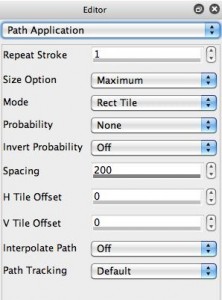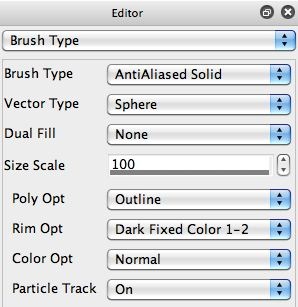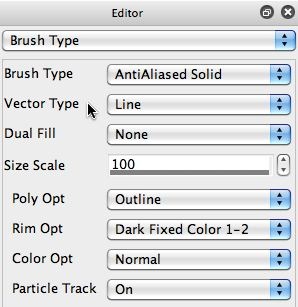The Brush Type control panel is set to use the AntiAlias Solid Brush Type. This particular brush type generates vector painting (as opposed to raster painting). The 2nd gallery image above shows the Brush Type control panel settings used for the painting the tiled colored vector circles.
Note that the Vector Type parameter is set to Sphere. Vector spheres are painted like raster paint nibs, so the individual vector spheres of paint are restricted to tiling positions in the canvas.
The Brush Modulation control panel (3rd gallery image above) is configured to use a Random option for the Size Modulation parameter. This setting modulates the size of the individual tiled vector paint spheres. The combination of random brush size modulation in conjunction with the tiling path application restrictions is what generates the inset vector circles seen in the paint example at the top of the post.
For the second half of the ‘circuit board’ paint effect (the random sized solid vector lines that connect tiling center points), I made a single parameter edit in the Brush Type control panel (4th gallery image above). I changed the Vector Type parameter from Sphere to Line.
Depending on the setting of the Vector Type parameter for the AntiAlias Solid brush type, painting may lay down individual vector paint nibs (like the Sphere setting), or painting may directly generate solid vector paths (like the Line Setting). Directly generating vector paths is different than the normal paint synthesizer paint nib path application model. The tiling path application restraints act to restrict the end point of individual line segments, but a complete vector line is drawn between 2 tiling positioning.
The 2 paint presets I used to create the 2 different components of the ‘circuit board’ paint effect detailed above are available for download 8711.paint 8711a.paint
Try some manual painting with these 2 paint presets to get a better feel for how they work. You can also try out different Vector Type parameter settings in the Brush Type control panel as well. The Polygon and Spline options are also fun ones that generate solid paint paths between tiling center points.











